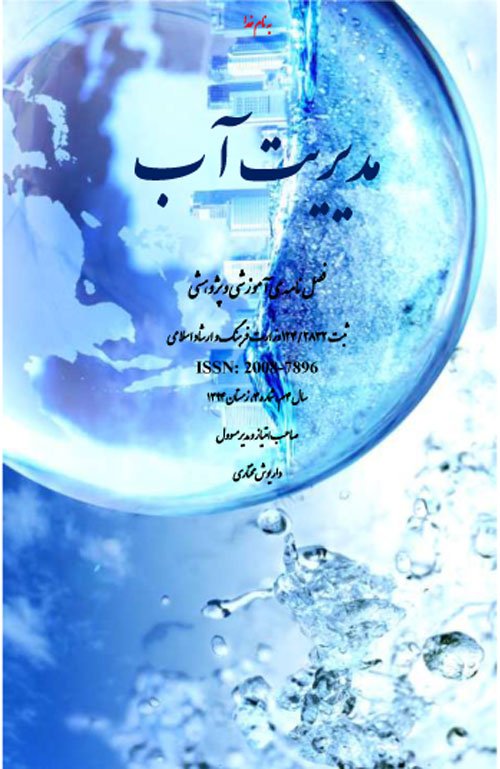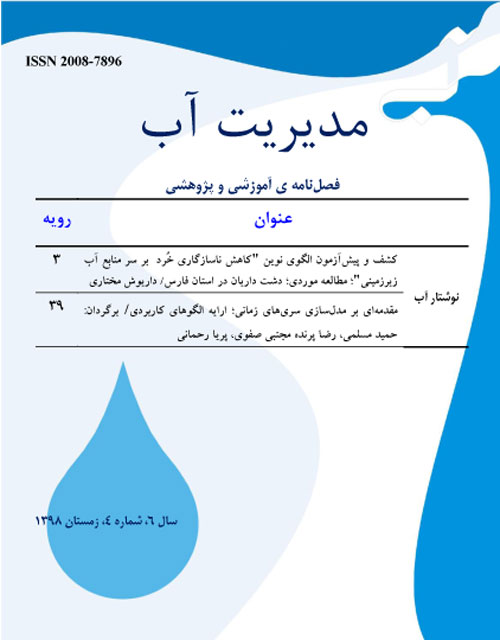فهرست مطالب

نشریه مدیریت آب
سال چهارم شماره 4 (پیاپی 11، زمستان 1394)
- تاریخ انتشار: 1394/12/19
- تعداد عناوین: 3
-
صفحات 3-12
گسترش و پیاده سازی طرح های تعادل بخشی در استان فارس کمک می کند که حمایت های فنی و اعتباری دولت بهتر به بهبود تراز سفره های آب زیرزمینی بینجامد. پرداخت هزینه نکاشت به برخی چاه ها و همینطور اجرای پروژه های معیشت جایگزین با کمک کمیته امداد امام خمینی و سازمان آموزش فنی و حرفه ای، تکمیل کننده راهکارهای تعادل بخشی است. در این صورت می توان انتظار داشت استان فارس از مخاطره بسیار بزرگی از ناحیه نابودی آبخوان هایش پیش رو دارد، رهایی یابد.
کلیدواژگان: منابع آب زیرزمینی، کشاورزی، طرح های تعادل بخشی، استان فارس -
صفحات 15-26
ایران به دلیل قرارگرفتن در کمربند خشک و نیمه خشک جهان در زمره کشورهای با محدودیت منابع آب قلمداد می شود. گرچه نوار شمالی از بارش فراوانی برخوردار هست ولی بخش بزرگی از کشور را مناطق خشک و نیمه خشک تشکیل می دهد. توزیع جریان های آبی در سطح جهان نیز نامتعادل است و با توزیع جمعیت تناسب ندارد. توزیع مکانی آب در ایران به دلیل شرایط طبیعی بسیار ناهمگن است. توزیع زمانی نزولات جوی در کشور نیز مانند توزیع مکانی روند مشابهی را نشان می دهد و میزان آن در سال های مختلف و حتی فصول مختلف متغیر بوده و این مساله مشکلات گوناگونی را در چند سال اخیر برای بخش های مختلف، به ویژه بخش کشاورزی و تامین آب شرب شهرها به همراه داشته و زیان های زیادی را به این بخش تحمیل کرده است. برداشت بی رویه آب از آب های زیرزمینی یکی دیگر از مسایل اساسی کشور در بخش آب به شمار می آید.
کلیدواژگان: محدودیت منابع آب، ایران، وضعیت آب، شاخص بهره وری آب -
صفحات 29-38
از افغانستان دو رود مهم به سمت ایران می آید؛ یکی هیرمند (هلمند) است که به سمت سیستان ایران می آمد و دیگری هریررود است که به سمت خراسان می رود. اکنون مقامات افغانستان به اهمیت آب پی برده و می خواهند از خروج آن به کشورهای همسایه جلوگیری نمایند. افغانستان با ساخت دو سد در عمل مانع ورود آب هیرمند به ایران شد و از دهه 40 به بعد، بخش عمده ای از جمعیت این ناحیه مهاجرت کردند. کمبود آب در برخی مناطق منجر به کاهش شدید کشت محصولات کشاورزی و بیکاری و خشک شدن تالاب ها شده است.
کلیدواژگان: هریررود، هیرمند، بحران آب، شرق ایران
-
Pages 3-12
The expansion and implementation of balancing schemes in Fars Province will help the government provide better technical and credit support to improve groundwater levels. Paying for some wells as well as implementing alternative livelihood project with the help of imam Khomeini's relief committee and the vocational education and training organization complements the balancing strategies. In this case, one can expect the Fars province to get rid of the huge danger it faces from destroying its aquifers.
Keywords: Ground water resources, Agriculture, balancing schemes, Fars province -
Pages 15-26
Iran is considered among the countries with limited water resources due to being placed in the arid and semi-arid belt of the world. Although the northern part of the country has a lot of rainfall, much of the country is dry and semi-arid. The distribution of water flows worldwide is also unbalanced and does not fit the population distribution. The spatial distribution of water in Iran is very heterogeneous due to natural conditions. The temporal distribution of atmospheric downturns in the country is similar to that of spatial distribution and its rate in different years and even in different seasons were varied and this has caused many problems in the past few years for various sectors, especially agriculture and cities water supply and have caused a lot of damage to this sectors. Indisputable withdrawal of Underground water is another major issue in the water sector.
Keywords: Water Resources Constraint, Iran, Water Status, Water Productivity Index -
Pages 29-38
There are two major rivers from Afghanistan to Iran; one is Himand (Helmand) which goes to Sistan of Iran and the other is Harirrud which goes to Khorasan. Afghan authorities are now aware of the importance of water and want to prevent it from coming to neighboring countries. Afghanistan, by building two dams, effectively prevented Hirmand river from entering to Iran, and since the 40s AH, a large portion of the population has migrated. Lack of water in some areas has led to a sharp decline in crop production and unemployment and wetland drying up.
Keywords: Harirood, Hirmand, Water Crisis, East of Iran


